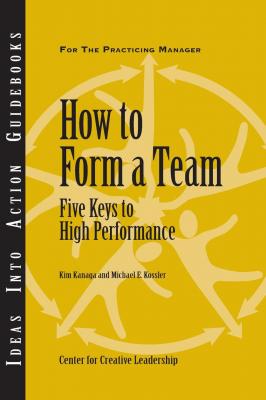How to Form a Team: Five Keys to High Performance. Michael Kossler E.
Чтение книги онлайн.
Читать онлайн книгу How to Form a Team: Five Keys to High Performance - Michael Kossler E. страница

AN IDEAS INTO ACTION GUIDEBOOK
How to Form a Team
Five Keys to High Performance
IDEAS INTO ACTION GUIDEBOOKS
Aimed at managers and executives who are concerned with their own and others’ development, each guidebook in this series gives specific advice on how to complete a developmental task or solve a leadership problem.
| LEAD CONTRIBUTORS | Kim Kanaga |
| Michael E. Kossler | |
| CONTRIBUTORS | Henry Browning |
| Sonya Prestridge | |
| GUIDEBOOK ADVISORY GROUP | Victoria A. Guthrie |
| Cynthia D. McCauley | |
| Russ S. Moxley | |
| DIRECTOR OF PUBLICATIONS | Martin Wilcox |
| EDITOR | Peter Scisco |
| WRITER | Janet Fox |
| DESIGN AND LAYOUT | Joanne Ferguson |
| CONTRIBUTING ARTISTS | Laura J. Gibson |
| Chris Wilson, 29 & Company |
Copyright © 2001 Center for Creative Leadership.
All Rights Reserved. No part of this publication may be reproduced, stored in a retrieval system, or transmitted, in any form or by any means, electronic, mechanical, photocopying, recording, or otherwise, without the prior written permission of the publisher. Printed in the United States of America.
CCL No. 414
ISBN-13: 978-1-882197-68-2
ISBN-10: 1-882197-68-2
CENTER FOR CREATIVE LEADERSHIP
AN IDEAS INTO ACTION GUIDEBOOK
How to Form a Team
Five Keys to High Performance
Kim Kanaga and Michael E. Kossler
THE IDEAS INTO ACTION GUIDEBOOK SERIES
This series of guidebooks draws on the practical knowledge that the Center for Creative Leadership (CCL®) has generated in the course of more than thirty years of research and educational activity conducted in partnership with hundreds of thousands of managers and executives. Much of this knowledge is shared—in a way that is distinct from the typical university department, professional association, or consultancy. CCL is not simply a collection of individual experts, although the individual credentials of its staff are impressive; rather it is a community, with its members holding certain principles in common and working together to understand and generate practical responses to today’s leadership and organizational challenges.
The purpose of the series is to provide managers with specific advice on how to complete a developmental task or solve a leadership challenge. In doing that, the series carries out CCL’s mission to advance the understanding, practice, and development of leadership for the benefit of society worldwide. We think you will find the Ideas Into Action Guidebooks an important addition to your leadership toolkit.
Table of Contents
Create an Empowering Team Structure
Team Formation: A Special Event
EXECUTIVE BRIEF
Team success doesn’t start with results. It starts with the building of an effective team that can deliver on its promise. This book is for managers and leaders who have responsibility for the creation and success of teams. If you are a department head or project manager, or if you are the senior-level champion or sponsor of a proposed team, this guidebook will help you understand the five factors critical to building effective teams and show you how to use those factors to lay the groundwork for successful teams.
What Is a Team?
Many kinds of workgroups exhibit cooperative attitudes and practices and might be described as teams. But in this guidebook team refers to a specific kind of group whose members are collectively accountable for achieving the team’s goals. Typically, a team has these five characteristics:
1. Members of the team are dependent upon each other for the completion of a complex task. It’s often advisable to form a team when the task is complex and actually requires the interdependent efforts of a diverse group of people. This typically occurs when the members of a team represent different functional areas of an organization; for example, R&D, engineering, manufacturing, and marketing.
2. Members possess different but complementary skill sets. In many types of workgroups (a company’s sales force, for instance), the members all possess similar perspectives and skills. A defining characteristic of a team is that members bring different sets of skills (and usually different backgrounds and perspectives) to the task. Just as an effective baseball team needs good hitters, good pitchers, and good fielders, a business team needs a combination of abilities to be effective—a combination rarely, if ever, found in a single individual.
3. Teams manage their own work within boundaries set by the organization. Teams are quite autonomous compared to other kinds of groups. A team may be charged with carrying out its work within a specified time period, and may be accountable to a specific individual or management group. But effective teams typically have considerable latitude in how they carry out their work. They decide for themselves how often